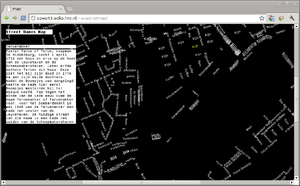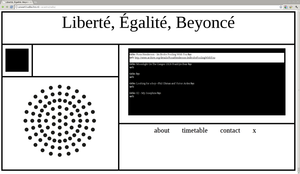User:Andre Castro/2.1/semniar-2012-10-10-summary
Project Proposal Draft
Short Description
Departing from today's unstable notion of what constitutes a book, I would like to further problematize it. My approach will consists developing textual contents, that are commonly seen as marginal, or unsuitable to be featured on print, and base a whole book on them.
Currently, specially with the great popularity of e-readers and print-on-demand services books are becoming more and more like the web, not only in their underlying technology, but also in their publishing mechanisms. Similarly to what happened with the blog boom, which made on-line publishing possible to anyone with access to a computer, the current book publishing revolution (with ebooks and print-on-demand services as two of its main agents) is bypassing publishing houses and opening the book medium to amateur writers. At first sight this appears to be an extremely liberating possibility, allowing writers to break away from dependency to publishing houses. However such possibility also appears to bring along fears and anxieties, resulting from the lack of control over what is published. When its validating mechanisms are no longer in practice, what knowledge will be considered legitimate? Will the books' authority still hold up to all these changes?
Despite these changes print seems to non-the-less hold a certain degree of authority, at least more than the web. Once a text is printed and bound into a book it gains another status and a more attentive readership. As an example, Wikipedia is giving now users the possibility to compile various article into a book, which can be downloaded or bought as a paperback.

But what happens when we are presented with a book based on textual detritus, on material considered unsuitable to be featured into a book? Is the figure of the book able to sustain the status and readership of its textual content?
The project I intend to develop will focus on the publication of books based on spam email messages. My plan consists in finding strategies which, no only aim at generating large quantities of text material based on spam, but also disguise it under the literary genre of folk tales.
Description of my works in the past year
To begin with I started by writing on the performativity of code. Departing from Katherine Hayle's notion of code performativity I went on looking at how does code perform. How does code, rather than being a descriptive tool, has the capacity to act, to change things in the real world, similarly to a performative speech-act, such as a judge stating: "I pronounce you guilty of the crime", and often with very direct and material effects.
Simultaneously I developed and online map of the streets of Rotterdam. This map - a striped-down version of the original map of Rotterdam - only displayed the city street names against a black background, on the browser. By clicking on each street a request was made to the City of Rotterdam's Archive to provide information on that particular street's name origin. That information was then displayed alongside the map.
What I seemed to be creating here was an interface to access city's archive through a different channel. By having the indexes of the archive - the street names - displayed on the screen I might see and ask for information on streets that I wouldn't be normally interested in. It opened up the possibility for a serendipitous navigation through the city name's history.
The same serendipitous exploration made its way to the next project, Radio Liberté Egalité Beyoncé (RLEB). RLEB was an online radio-station with a schedule composed of audio content fetched form Internet Archive. One-hour long cycles presented the listener with ten-minutes chunks of various sound materials, picked at chance the archive, from within a specific categories, such as french talk-shows, hiphop, poetry readings, ambient music, etc. The design of website where RLEG was hosted presented a drawing of radio, with which the listener had to interact in order to get the radio playing.
The essay written alongside the RLEB began by tracing the archive's historical ties to power, functioning as a legitimator of power and knowledge. It mentioned the ideology which underlies any archive, even folkloric archive such as Youtube, an which can be best perceived through what is kept from entering the archive. Never-the-less important differences exist between a physical offline archive and a digital online one: the latter has the potential of a wider access, and also to let its item be taken by visitors, without risk of impoverishing it. These differences result in an invitation for appropriation and transformation of the digital archive. When one of its items is taken and transformed, a new version of it appears, and a certain confusion emerges over its origin - which one is the original and which is fictitious? When remixed versions surface, they change the archive into a space of dialogue and emergence of discourses, rather than a site aimed at legitimizing power and knowledge.
Data Factory looked at direct marking companies' acquisition of consumers data, with the aim to target individual consumers with products which they might be more inclined to buy. It consisted of a small archive of recordings from phone-calls made to such companies. During the calls I tried to sell them their business main ingredient - consumer data - with the catch being the fact that "consumer" here meant only myself. Through the reactions to this simple short-circuit the ideology behind such business model became more apparent. The calls were gathered together in a website, with a certain corporate style, in which they could be listened to, in parallel to images illustrating or ridiculing what was being said.
The essay The Work of Audiences departed from Dallas Smythe's work On the Audience Commodity and its Work. In Smythe's view, the audience job consists in creating demand for advertised goods. What advertisers buy when placing an advert on a magazine, TV-show of website is the audiences' attention and their capacity to buy what is being advertised. It happens that the labor of this immaterial work-force changed under the Web 2.0, as noted by Andrejevic. Audiences are no longer simply asked to generate demand for advertised goods, but also to put their creativity to work in producing many of the contents that surround those adverts, and also make the Web. By doing so audiences also develop a community around their creations, and produce information about their behavior, which will be used in targeting advertisement directed at them. In exchange audiences receive a small amount of control over their creations, which are ultimately property of the company hosting them. Following this line of thought I asked whether there was a difference from the work of audiences on platform like Youtube to one like Wikipedia. The situation seems to be that although Wikipedia also lives on audiences' free creative labor, they are given more control over their creations, and engage in discussions over the functioning of Wikipedia. Is this difference enough for the work of audiences to be classified as less exploitative than on Youtube?
General Methodology of Work
The methodology I have employed in the constructions of my works generally begins by encountering a problem or frustration. I come across something in which I see potential, but due to some blockage, it is under-explored. As an example, I found a great wealth of audio material available at Internet Archive, however its interface tended to conceal most of the material. This frustration led me to ask how could the diversity and quantity of material become more apparent and accessible.
A stage of experimentation and research generally follows. At this point I try to broaden my question, find possible angles to approach it, find other approaches to similar problems, engage with my subject and experiment. The Engage with the subject seems crucial. It is a step towards the object of research, trying no to look at it from a distance, but to get close to it, to establish a dialog. This happen more clearly in Data Factory when I tried to engage direct-marking companies' employees into talking with me and clarifying my questions a bout direct-marking and users' privacy.
Loose experimentation seems also important to my work methodology. From it a more precise idea about the materials I am engaging with is formed, and the final approach begins to surface.
The following stage is one of concretization of the elected approach, bringing it from its experimental stage, through various prototypes to its final from. It is at this point when most decisions are made, such as what to include or exclude, in what context should the project exist, how it will function, what will be its appearance. In the example I have been giving, I decided for an online radio, exclusively based on audio material from IA, that would group the sound materials under given programs with specific genres.
The resulting object is rarely, a solution for the problem which initiated the work process. Rather than providing an answer it will be an imaginative solution that ought pose more questions, and show the problem under another, perhaps unexpected, perspective. Hopefully such approach will challenge the value of the object in question, and allow it to reveal itself under another form.
Project Methodology
My project will attempt to induce spammers to write folk-tales. My approach to it will be segmented into the following steps:
- A) Creation of series of online entities (bots) with an active online life. These bots will work hard to publicize their email address and wait for unsolicited emails to arrive.
- B) Upon arrival of a spam email each bot responds to it, beginning an exchange with the spammer. At this stage the bot is suppose to captivate the spammers' attention.
- C) The bot begins to shape the dialog between the two into an intrigue in which the spammer becomes a character, a player.
- C.1) I am still uncertain about how this intrigue will be devised. I am currently looking at AI systems such as chat bots and story generators, and structural analysis of folk-tales.
- D) The tale is concluded. (Final must be arranged. Possibly the resulting text is offered to the spammer, inviting him to publish it and a make some profit out of it).
- E) After several texts are produced using this approach, the results must be compile and published under a (print and electronic) book.
Current Stage
Right now I sketching the previously mentioned work stages and assessing the viability of each one of them.
So far I have established successful communication with a couple of spammers, using as only identity card and email address. And at this very moment I began introducing bits computer generated text, using Eliza, into my email exchange with Mr.Wang. This is not the approach I would like to take, but for now seems a good way of testing how far can I stretch the level of non-sense.



